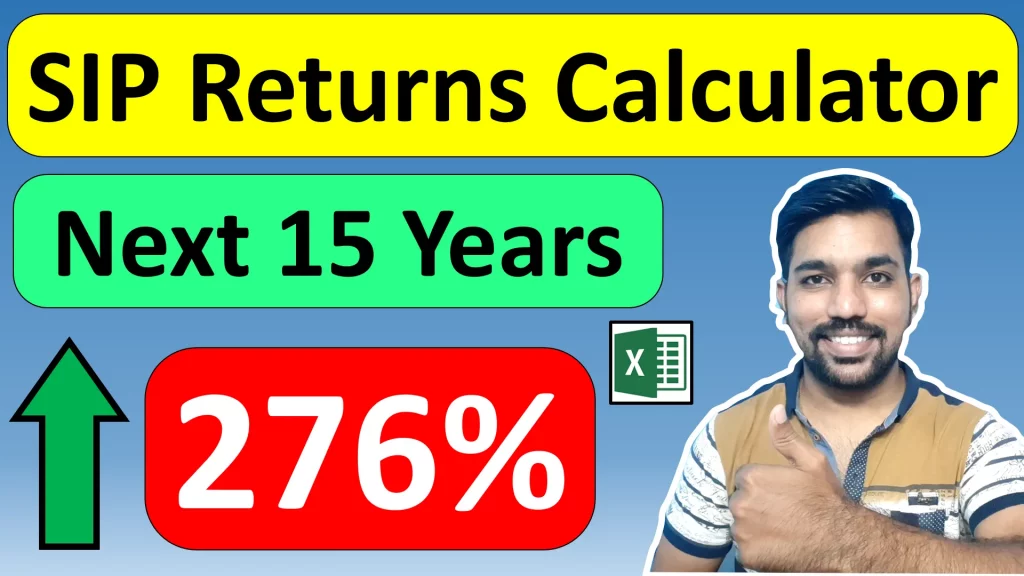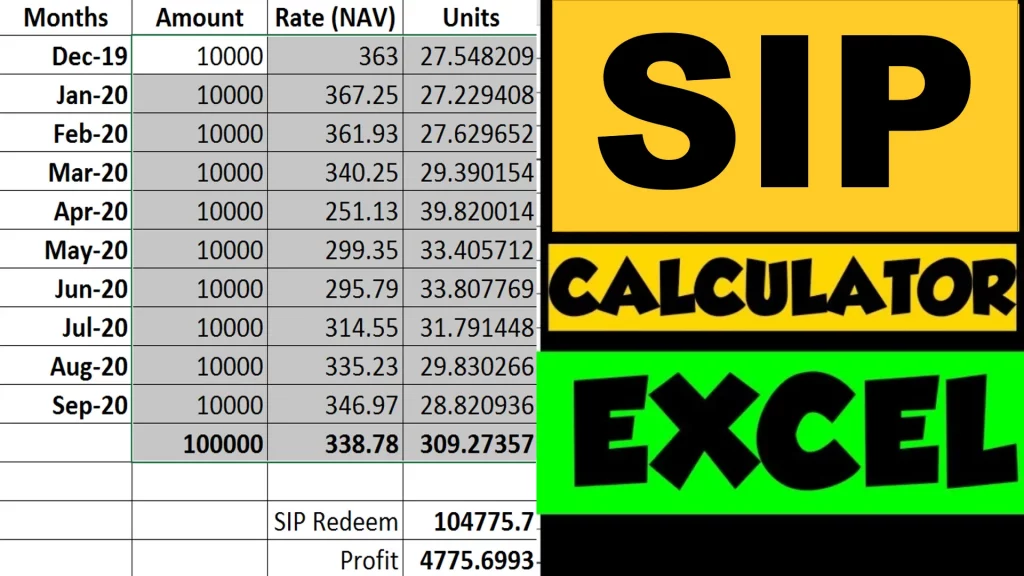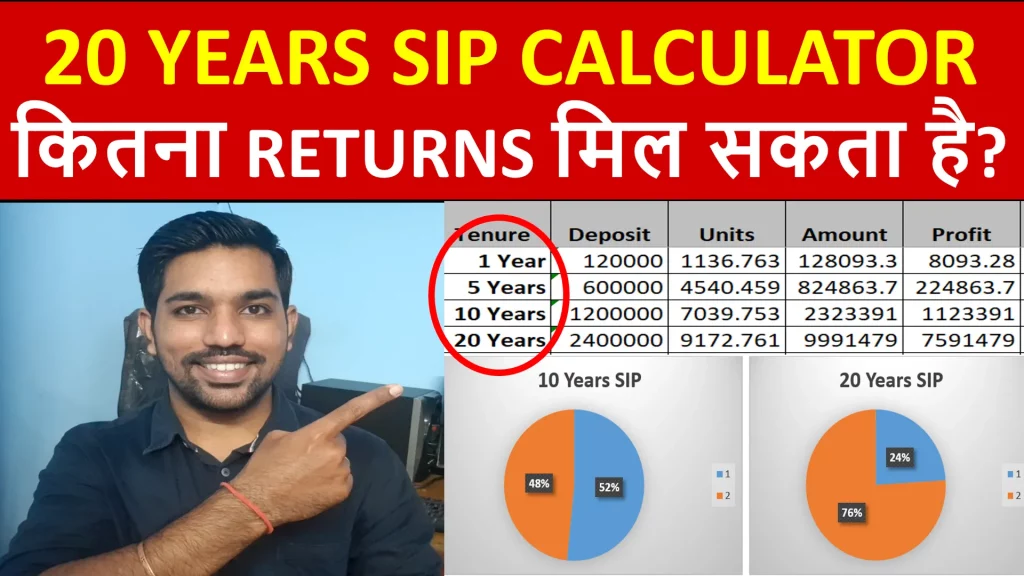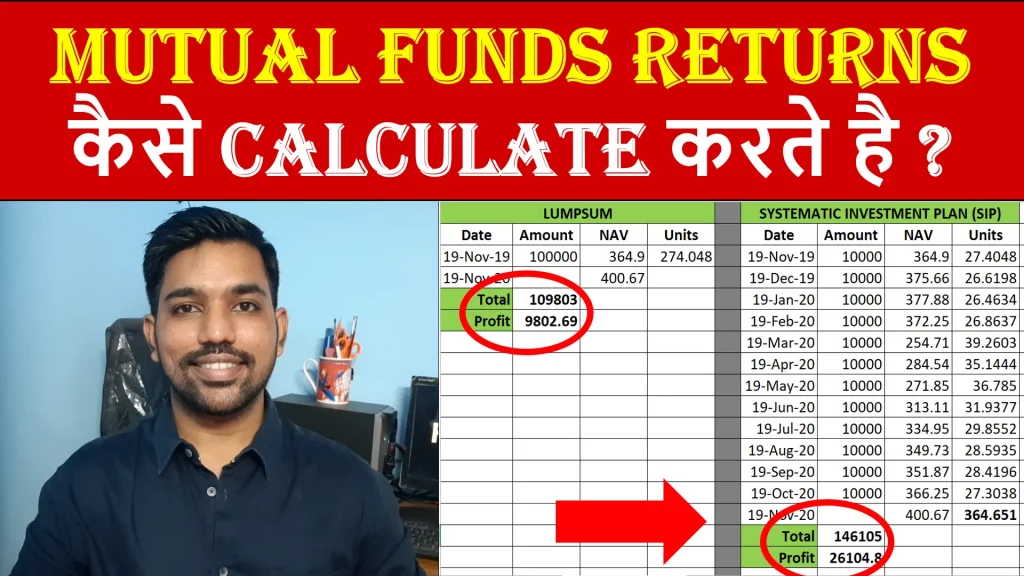SIP and Lump sum Returns Calculator will help you to achieve your financial goals on time. One of the most asked questions on my YouTube Channel is – how to perform SIP and Lump sum returns calculation in any mutual fund for upcoming 5, 10, 15, 20, 25 or even 30 years using both SIP and Lump sum investments. Do we have any SIP and Lump sum Returns Calculator in Excel? YES, we have!
You can easily calculate Returns of any Mutual fund for next 30 years using the excel calculator I have provided in this article. Mutual Fund Returns excel calculator with SIP and Lump sum investment options will help you to understand the total amount you will be able to accumulate over a period of time.
It is important to note that you achieve best results in mutual fund investments when you invest for longer duration. SIP or Systematic Investment Planning will help you to get the benefit of Rupee-cost averaging, which means you will buy more mutual fund units when the market is down, thus giving you more profits. But, Lump sum investment is something where you will get more returns than SIP, considering you invest for a very long time. SIP and Lump sum Returns Calculator will help you calculate returns in both cases
Note: You can find the mutual fund returns calculator for investment up to next 30 years via SIP and Lump sum options at the bottom of this article.

Read on to get more information about how to work with Excel calculator and how mutual fund investment works.
- SIP and Lump sum Returns Calculator Video In Excel
- What are Mutual Funds
- NAV of Mutual Fund
- What is Expense Ratio
- How to Invest in Mutual Funds
- What is SIP and How SIP works
- SIP vs Lump sum Investment
- SIP Benefits & Advantages
- SIP Returns Calculator EXCEL
- Types of Mutual Funds
- SIP in Mutual Fund to Save Income Tax
- Mutual Fund Withdrawal
- Mutual Fund – Things to Remember before investing
- DOWNLOAD SIP and Lump sum Returns Calculator
- Conclusion
- Frequently Asked Questions (FAQs)
SIP and Lump sum Returns Calculator Video In Excel

What are Mutual Funds
- Unlike stocks investing, mutual funds invests your money in multiple companies thus reducing the risks
- Every mutual fund is assigned a Fund Manager who manages that mutual fund
- Fund manager is responsible to select percentage of stocks to invest your money in, to give you better returns
- Unlike stocks investing, you need not have to worry about selecting and monitoring stock performances while investing in mutual funds. Fund manager does the job for you
- Below is the screenshot of the portfolio (list of stocks) of one the popular mutual funds in India

Love Reading Books? Here are some of the Best Books you can Read: (WITH LINKS)
NAV of Mutual Fund
ALSO READ: Compounding in Stock Market with Examples
What is Expense Ratio
Expense ratio is a small percentage taken by AMC (Asset Management Company) to manage your funds. You need not have to pay additionally as a part of Expense Ratio.
Expense Ratio amount is recovered from your profits that you make. Usually, expense ratio of regular mutual funds are high compared to those of direct mutual funds. You can get details of expense ratio of every fund on the mutual fund page.
How to Invest in Mutual Funds
There are 2 ways you can invest in Mutual Funds:
ALSO READ: Invest in SBI Mutual Fund Online
What is SIP and How SIP works
- SIP full form is Systematic Investment Plan. This means you systematically invest specific amount in a disciplined manner every month based on your goals
- The SIP amount you invest is used to buy Mutual Funds units every month
SIP vs Lump sum Investment
As mentioned above, SIP is investing in a systematic manner every month, on the other hand Lump sum investing is investing your entire amount in one go instead of investing systematically every month.
Example
- Let’s say you have Rs. 1,20,000 to be invested in a mutual fund
- In SIP, you will divide this amount to be invested over a year so your SIP amount every month will be Rs. 10,000, of Rs. 5000 to be invested over the period of 2 years
- In Lump sum investing, you will invest entire Rs. 1,20,000 in one go, without dividing it into multiple months investment
- The calculation of number of units allocated to you remains same as mentioned above
- But while investing in lump sum, there might be a risk you are taking since you cannot predict market. If market crashes next month after your lump sum investing, your investment value might be negative
SIP Benefits & Advantages
- Allows you to invest only a fraction of amount instead of entire corpus in one go. You can choose this fraction of amount as SIP based on your affordability
- You can have multiple SIPs based on your goals whether they are short term, medium term or long term goals
- SIPs are flexible these days. You can choose to pause a SIP for few weeks or months, or stop SIP if your goal is achieved before time
- You become disciplined in working towards goals with given timelines
ALSO READ: Rs. 1000 SIP Returns Calculation Examples
SIP Returns Calculator EXCEL
You can easily calculate SIP returns using excel document (link at the bottom of post).
This excel will help you know your future SIP returns with just 2 inputs – SIP Amount & Expected Returns
Here are the screenshots of some SIP returns:
SIP Amount = Rs. 5000, Expected Returns = 10%:

SIP Amount = Rs. 5000, Expected Returns = 12%:

SIP Amount = Rs. 10000, Expected Returns = 10%:

SIP Amount = Rs. 10000, Expected Returns = 12%:

Types of Mutual Funds
- There are 3 types of mutual funds: Equity, Debt and Hybrid mutual funds
- Debt mutual fund: Mutual funds that invest in bonds or instruments. They have low risk and low returns
- Hybrid mutual fund: Mutual funds that invest in a combination of Equity and Debt instruments. They have medium risk and medium returns
- Based on your risk appetite and your goals, you can choose between above categories of mutual funds
SIP in Mutual Fund to Save Income Tax
- You can invest in one type of mutual fund called ELSS (Equity Linked Saving Scheme) that helps is saving Income Tax under Section 80C
- Maximum deduction allowed under Section 80C is Rs. 1.5 Lacs (as of FY 2021-22)
- ELSS has a lock-in period of 3 years
- You can invest via SIP in ELSS to achieve your goals and save income tax at the same time
How to Save Income Tax Video

Mutual Fund Withdrawal
- After your SIP investments are complete and you no longer need or want to invest via SIP, you can either choose to stop SIP and redeem (withdraw) all your Units or keep them invested to grow more
- When you redeem the units, it depends whether to sell all the units or partially you can select the number of units to be sold
Mutual Fund – Things to Remember before investing
- While you are searching for a good mutual fund, you should see how the fund has performed in past
- You should also see the expense ratio of the fund and how much money is invested in the fund which is called AUM (Asset under management). Lower the expense ratio of the fund, more returns you’ll receive
- You should only invest in Direct mutual funds for better returns which also have low expense ratio compared to their regular fund counterpart
- Remember to link your mutual funds investments with goals. And once your goal is achieved, you can stop investing and reap the benefits
- Never book losses in mutual funds. If the market is down, wait for the market to come up so that you are in profit
- It is always better to divide your money and invest via SIP (Systematic Investment Planning) compared to investing as lump sum. Never try to time the market to get best returns.
- If someone says they can maximize your returns and ask you to lend them your money, just run away and never look back
DOWNLOAD SIP and Lump sum Returns Calculator
Click below button to download lumpsum + sip calculator excel:
Conclusion
You can easily use the SIP + Lump sum calculator in excel to calculate your returns over next 30 years. This will help; you in planning and achieving your goals before time.
It is important to note that you should not try to time the market. Nobody can predict the next bottom in the market so continue with SIP investments and whenever possible, make lump sum investing to get better returns from market.
Some more Reading
- Tax on Short Term Capital Gains
- Rs. 2000 SIP Returns Calculation for 15 Years
- How to Open NPS Account Online
Frequently Asked Questions (FAQs)
What is the Full Form of SIP?
SIP full form if Systematic Investment Plan. Usually SIP is a specific amount you invest every month to achieve specific goals with specific tenure (time period)
How SIP works?
SIP is the specific amount you invest every month for a specific goal with a specific period of time. You invest an amount of let’s say Rs. 5000 every month for 5 years and with expected returns of 10% per year. In this case, after 5 years your expected investment value would be Rs. 3,90,411 according to the SIP returns excel calculator provided above. This makes you a profit of Rs. 90,411 in 5 years and also helps you achieve your goal.
What is lump sum investing?
Lump sum investing means you invest entire amount in one go. Let’s say you have Rs. 1,20,000 to be invested for a year. In SIP, you divide this Rs. 1,20,000 for 12 months (1 year) and invest Rs. 10,000 every year in a mutual fund. On other hand, in lump sum investing, you invest entire amount of Rs. 1,20,000 in first month in one go. This is called lump sum investing.
What is better SIP or Lump sum investing?
Combination of both SIP and Lump sum is better. You can continue with your SIP during normal days and invest lump sum amount if available when market goes down. This way you get more units when market is down and make more profits during market crash.
Save Home Loan Interest Amount!
Use Home Loan Excel Calculator that will help you to Save Interest Amount on Home Loan EMI.
Click below button to download Home Loan EMI and Prepayment Calculator in Excel:
Watch how Home Loan Calculator in Excel Works
Income Tax Calculator App – FinCalC
For Income Tax Calculation on your mobile device, you can Download my Android App “FinCalC” which I have developed for you to make your income tax calculation easy.
What you can do with this mobile App?
- Calculate Income Tax for FY 2025-26 and previous FY 2024-25
- Enter estimated Investments to check income tax with Old and New Tax Regime
- Save income tax details and track regularly
- Know how much to invest more to save income tax
- More calculators including PPF, SIP returns, Savings account interest and lot more

Use Popular Calculators:
- Income Tax Calculator
- Home Loan EMI Calculator
- SIP Calculator
- PPF Calculator
- HRA Calculator
- Step up SIP Calculator
- Savings Account Interest Calculator
- Lump sum Calculator
- FD Calculator
- RD Calculator
- Car Loan EMI Calculator
- Bike Loan EMI Calculator
- Sukanya Samriddhi Calculator
- Provident Fund Calculator
- Senior Citizen Savings Calculator
- NSC Calculator
- Monthly Income Scheme Calculator
- Mahila Samman Savings Calculator
- Systematic Withdrawal Calculator
- CAGR Calculator
I’d love to hear from you if you have any queries about Personal Finance and Money Management.
JOIN Telegram Group and stay updated with latest Personal Finance News and Topics.
Download our Free Android App – FinCalC to Calculate Income Tax and Interest on various small Saving Schemes in India including PPF, NSC, SIP and lot more.
Follow the Blog and Subscribe to YouTube Channel to stay updated about Personal Finance and Money Management topics.









